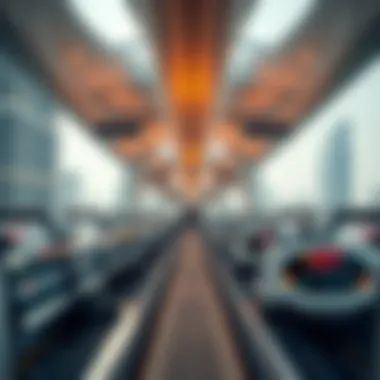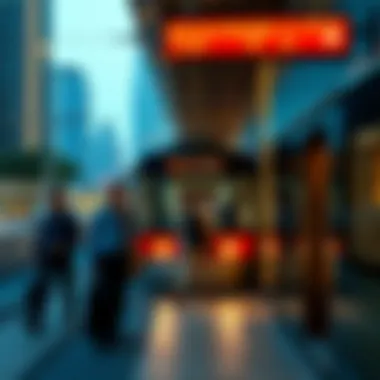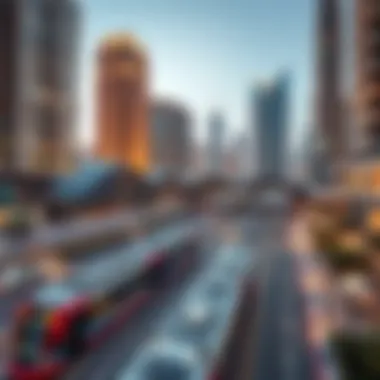Marina Towers Tram Station: Key to Dubai's Connectivity


Intro
Dubai's skyline is a testament to modern ingenuity and ambition. Among its various architectural wonders, Marina Towers Tram Station stands out as a vital hub for connectivity in the bustling city. Here, we dive into the multifaceted aspects of this tram station, which not only enhances urban mobility but also stitches together the community fabric of the surrounding neighborhoods. This exploration is essential for a variety of stakeholders — from investors to homeowners — who seek to understand the strategic relevance of this transit point within the larger context of Dubai’s burgeoning real estate and transportation landscape.
As urban centers are reliant on efficient movement, Marina Towers Tram Station plays a crucial role in alleviating congested roadways and providing a seamless travel experience. This article will unpack the tram station’s architectural features, its integration with the surrounding infrastructure, and how it stands as a beacon of opportunity for future investments and developments.
The analysis will touch upon current market trends, socioeconomic impacts on the local populace, and the evolving dynamics of real estate in Dubai driven by the station's presence. Ultimately, we aim to furnish you with in-depth insights left wanting by conventional analyses — let's shed light on what makes Marina Towers Tram Station a focal point in this vibrant city.
Prelude to Marina Towers Tram Station
Marina Towers Tram Station serves as more than just a stop on a transit line; it is a pivotal point in the complex web of connectivity that characterizes Dubai's transportation framework. Nestled within a bustling urban area, this station is a concrete manifestation of Dubai's commitment to integrating modern transit solutions into everyday life.
For those living in or near this vibrant locale, the station represents an invaluable asset. It provides convenient access not only to the surrounding neighborhoods but also to major commercial hubs and entertainment venues. By being part of the expansive Dubai Tram system, it enhances the reach of public transport, allowing commuters to traverse the city with ease.
One notable aspect of the Marina Towers Tram Station is its strategic location. Situated close to key attractions and residential areas, it serves as a major transit hub that facilitates the daily commute for thousands. We cannot overlook the station's interconnectedness with other forms of transportation, such as buses and the metro. This synergy plays an essential role in reducing traffic congestion while promoting the use of eco-friendly transport options.
Moreover, its architectural design reflects an aesthetic that complements the modern skyline of Dubai. But it’s not just about looks; the station also implements functional features that improve the overall commuter experience, making it user-friendly.
In summary, Marina Towers Tram Station is not only a transit point; it symbolizes the evolution of urban mobility in Dubai. By examining its complexities and influences, we gain deeper insight into how it aligns with the city's growth plans, serving the needs of investors, homeowners, and city planners. Understanding its role positions stakeholders to make informed decisions about the broader implications of urban transport developments.
Location and Accessibility
When it comes to the allure of urban living, the location and accessibility of transport hubs like the Marina Towers Tram Station cannot be overstated. A well-situated tram station acts as a lifeline in a bustling city like Dubai. With its thriving business districts, cultural centers, and residential pockets, ease of access becomes paramount for residents, visitors, and investors alike.
Geographical Context
Nestled in a vibrant urban landscape, the Marina Towers Tram Station is positioned to serve not only the immediate vicinity but also the broader Dubai metropolitan area. Surrounded by iconic skyscrapers and luxurious waterfront properties, the station places commuters right in the pulse of the city's activity.
Its geographical context offers seamless connectivity to several notable locations:
- Dubai Marina: Just a stone’s throw away, known for its entertainment and retail options.
- Jumeirah Beach Residence: A sought-after locale for both tourists and locals.
- Palm Jumeirah: Recognized globally, it draws visitors from all corners.
Being centrally located means residents have quick access to the best that Dubai offers without the hassle of lengthy commutes.
Transport Links
The Marina Towers Tram Station isn't just a point on a map—it's a nexus that integrates various transport modes that enhance mobility within the city. Effective transport links are crucial for a city's functionality, creating a web of connectivity that promotes economic growth and social interaction.
A few significant transport links include:
- Tram Services: The station is part of Dubai's extensive tram network, which directly connects to key areas, reducing travel time.
- Metro Access: Nearby metro stations complement tram services, allowing smooth transitions between different modes of transit.
- Bus Connectivity: Several bus routes traverse the area, further enhancing the accessibility and making it easier for citizens to flow in and out of the city.
- Water Taxis and Ferries: For those who prefer a scenic route, water transport options are close at hand, connecting the tram station to various waterfront attractions.
In summary, the Marina Towers Tram Station serves as a vital fulcrum of local transit, amplifying accessibility for daily commuters and contributing to the wider landscape of urban mobility in Dubai. The combination of geographical advantages and comprehensive transport links emphasizes its importance in the city’s overall transport infrastructure.
Architectural Design of Marina Towers
The architectural design of Marina Towers Tram Station stands as a testament to modern urban planning. It encapsulates both aesthetic appeal and functional efficiency, transforming the structure into more than just a transportation hub. The design elements in play not only enhance the station’s exterior but also ensure a seamless experience for commuters and travelers alike. As urban areas continue to grow, the demand for well-designed transport hubs becomes even more critical. Marina Towers aims to meet these expectations by marrying innovative design with usability.
Overview of Design Concepts
The design concepts behind Marina Towers Tram Station draw from a blend of contemporary trends and local architectural heritage. This station integrates features that promote a sense of place while providing practical solutions for the movement of people. Key design concepts include:
- Open Spaces: The use of open space within the design encourages natural light to flood the interior, creating an inviting atmosphere for users.
- Functionality: Every element, from ticket counters to waiting areas, is purposefully laid out to facilitate smooth foot traffic.
- Symbolism: Elements in the design resonate with the cultural nuances of Dubai, serving as a reminder of the region’s history while embracing future growth.


Through these design choices, the station stands as a beacon of connectivity in a bustling cityscape.
Materials and Aesthetics
When it comes to materials, Marina Towers Tram Station employs sustainable options that echo the overarching ethos of Dubai’s commitment to green practices. The selection of materials plays a pivotal role in both the aesthetics and the environmental footprint of the station. Key considerations include:
- Sustainable Materials: Use of recycled polymers and locally-sourced stones to minimize the energy consumption involved in transportation.
- Visual Appeal: A façade that reflects the shimmering skyline of Dubai, complete with glass panels that provide panoramic views of the surrounding area.
- Resilience: Materials must also withstand the extreme weather conditions, ensuring durability and longevity for the station’s structure.
In essence, the combination of thoughtful materials with striking aesthetics not only enhances the station's appeal but also serves the broader goals of sustainability and endurance.
"Good design is not just about how things look, but how they work, and at Marina Towers, this philosophy resonates in every aspect of its architecture."
This blend of design concepts and material choices positions Marina Towers Tram Station as an example worth emulating for future projects in Dubai and beyond.
Integration with Urban Infrastructure
Integrating the Marina Towers Tram Station into the broader urban infrastructure of Dubai is not merely about placing a stop along a route; it represents a significant shift toward a more connected urban environment. The tram station serves as a cog in the intricate wheel of public transport, enhancing connectivity between various urban locales. As a result, it has become paramount for investors, homeowners, and urban planners to appreciate the profound implications of this integration.
Surrounding Developments
The area surrounding the Marina Towers Tram Station has seen considerable growth and development. New residential complexes, shopping malls, and recreational facilities are sprouting like wildflowers, contributing to a vibrant atmosphere. This growth isn’t accidental; the tram station acts as a magnet, drawing both developers and potential residents.
- Residential Projects: Nearby, one can find numerous high-rise condominiums that attract young professionals and families seeking proximity to urban amenities.
- Commercial Ventures: The proximity to the tram station also elevates the status of nearby businesses. Retail stores and dining options benefit tremendously from the foot traffic generated by commuters using the tram service.
- Green Spaces: Moreover, urban planners are increasingly prioritizing green parks and recreation areas complementing the infrastructural setup, ensuring a sustainable lifestyle for the residents.
This kind of multi-faceted development assists in establishing a well-rounded urban atmosphere, making the Marina Towers Tram Station not only a transit point but a catalyst for future urban growth.
Impact on Local Businesses
When it comes to businesses in the vicinity of the Marina Towers Tram Station, the conversation is crucial. These local establishments have experienced a transformation since the tram service began operations. The consistent flux of commuters has had a ripple effect, reinforcing the local economy.
- Increased Foot Traffic: With thousands of commuters passing daily, businesses are witnessing an uptick in sales. Cafes, restaurants, and shops have reported a rise in patronage.
- Collaborative Opportunities: Local businesses are also seeing opportunities to collaborate. For instance, tram operators and retailers have partnered to offer discounts, enhancing the attractiveness of both the tram service and local shopping.
- Economic Resilience: The tram station's influence extends to job creation as new businesses open, which directly stimulates the local economy.
“The connection between the tram station and local commerce is undeniable. It’s turned the area into an economic hub, knitting together different facets of urban life.”
In essence, the integration with urban infrastructure does not only facilitate transportation. It acts as a fundamental foundation for economic growth, community cohesion, and environmental sustainability in this part of Dubai. Investors and homeowners looking to capitalize on this nexus of connectivity will find myriad opportunities in this burgeoning locale.
For further in-depth insights about urban infrastructure development, you can visit Britannica or explore the implications of public transit related to urban planning at Wikipedia.
Socioeconomic Impacts of the Tram Station
The socioeconomic impacts of the Marina Towers Tram Station extend far beyond mere transportation functionalities. They encompass a multitude of elements affecting the local economy, property markets, community dynamics, and commuter patterns. Examining these influences not only sheds light on the immediate benefits of this transit hub but also unveils broader implications for the neighborhood and its dwellers. The tram station acts as an anchor in the bustling district, tugging at various economic levers that promote growth and connectivity.
Effects on Property Values
The presence of a tram station significantly influences property values in its vicinity. Generally, properties situated near transit hubs see an uptick in value, thanks to increased accessibility and the desirability of convenient commuting options. In the Dubai context, where a vibrant lifestyle intertwines with modern needs, being close to infrastructure like Marina Towers Tram Station becomes a prized attribute for investors and homeowners.
- Proximity Premium: Homes that are a stone’s throw from the station tend to fetch higher prices. Buyers are often willing to pay a premium for the ease of accessing work, leisure, or necessities.
- Investment Opportunities: For investors, proximity to a transport hub can enhance the rental yield of properties. A well-connected building is likely to attract tenants looking for convenience, thus ensuring steady demand.
- Long-term Growth: As development continues, the surrounding area may see increased commercial activities. This can further elevate property values, making early investment near the tram station not just savvy, but potentially lucrative.
The aforementioned effects on property values paint a clear picture: they aren't merely a byproduct of urban development. Instead, they form a crucial circuit within the economic engine of Dubai, fostering a cycle of attraction and valuation.
Commuter Demographics
Understanding the demographics of commuters who utilize the Marina Towers Tram Station provides valuable insight into the station's role in urban mobility. Each day, a diverse tapestry of individuals steps aboard—students, business professionals, and families—all navigating their daily lives. Their backgrounds and needs shape much of what the tram station serves to offer.


- Diverse User Base: The station accommodates a mixed bag of users, from young professionals heading to commercial sectors to school children traveling to educational institutions. This diversity highlights the station's functional importance.
- Economic Contributions: Different commuter profiles contribute uniquely to the local economy. Business workers may drive demand for nearby cafes and services, while families might frequent parks and recreational areas.
- Travel Patterns: Insights into commuter behavior, such as peak usage times and common destinations, can help authorities in planning future expansions or enhancements to services. Understanding who rides and when can refine operations and improve user experience.
As the tram station nourishes a multi-faceted commuter landscape, it affirms its role as a linchpin in urban infrastructure. Addressing the varied needs of these commuters further ingrains the tram station's importance in enhancing the overall connectivity of Dubai.
"A transport hub is not merely a place to catch a ride; it's where lives intersect and communities thrive."
By acknowledging the socioeconomic impacts of the Marina Towers Tram Station, observers can grasp its integral role in shaping not only individual destinies but also the forward momentum of the entire urban milieu. This ripple-effect of connectivity serves as a testament to the transformative power of well-planned transportation networks.
For more details about urban transit impacts, visit sites like Urban Institute or National Transit Database.
Commuter Experience
Understanding the commuter experience at Marina Towers Tram Station is pivotal for analyzing how this hub enhances urban mobility in Dubai. The station is not just a point of transit; it serves as a vital connector, weaving together diverse neighborhoods and facilitating the day-to-day activities of thousands of commuters. The experience of these users reflects the station's efficacy and significance within the broader transportation framework.
Facilities and Amenities
The facilities offered at the Marina Towers Tram Station play a fundamental role in shaping the overall commuter experience. Here, practical elements meet thoughtful design, resulting in an environment that caters to the needs of riders. Key amenities include:
- Clean and spacious waiting areas with comfortable seating, allowing commuters to relax while waiting for their tram.
- Retail kiosks and small convenience stores that sell snacks and beverages, turning a simple wait into a chance for refreshments.
- Wi-Fi connectivity, which is an essential feature for today’s on-the-go lifestyle. Commuters can catch up on emails, stream media, or browse the internet without a hitch.
- Elevators and escalators, ensuring easy access for individuals with mobility challenges.
- Digital screens displaying tram schedules and announcements in real-time, helping passengers plan their journeys effectively.
The careful balance between functionality and comfort makes these amenities stand out, enhancing the rider's experience and overall satisfaction.
Feedback from Riders
Rider feedback can provide invaluable insights into the staff and operations of the Marina Towers Tram Station. Here are some notable points drawn from commuter experiences:
- Many riders appreciate the punctuality of trams, indicating that time management significantly boosts their satisfaction.
- Cleanliness is another recurring theme in feedback, with users often mentioning that the upkeep of the station makes it a pleasant place to spend time.
- Some riders have pointed out areas for improvement, like the need for additional seating during peak hours, but overall sentiment remains positive.
- Community events organized at the station have been well received, creating a sense of belonging and making the station a communal hub.
As one commuter put it, > "I love that Marina Towers isn’t just about getting from point A to B; it feels like a part of my daily life. I see friends and neighbors here, and it converts a mundane commute into a social interaction."
The feedback from riders serves as a mirror reflecting the strengths of Marina Towers Tram Station while also illuminating areas where enhancements can be made. Its ability to create a welcoming atmosphere is critical for establishing long-term loyalty from its users and reinforcing its role as a key transportation nexus in Dubai.
Future Developments and Prospects
As the Marina Towers Tram Station stands as a pivotal component of urban transport in Dubai, its future development prospects hold significant weight. This section explores its role in shaping the neighborhood and its broader implications for the city’s transit framework.
Upcoming Projects in the Area
Several projects are underway or in the pipeline that aim to enhance not only the transportation network but also improve the neighborhood around the Marina Towers Tram Station. These developments are vital in creating a seamless transit experience for both daily commuters and occasional visitors.
- New Residential Complexes: Several high-rise residential projects are being developed nearby, attracting families and professionals willing to experience urban living close to public transport. These buildings are often designed with modern amenities, elevating the appeal of residing in the area.
- Retail and Commercial Spaces: The integration of retail spaces will support local businesses and provide commuters with diverse shopping options. Coffee shops, convenience stores, and restaurants are essential in promoting foot traffic and making the tram station a hub of economic activity.
- Park Improvements: Green spaces around the Marina Towers Tram Station are also being upgraded. These parks not only enhance the aesthetics but also provide a respite for commuters who may want to unwind before or after their travels.
All these projects reflect a commitment to creating a well-rounded urban environment where transport links effectively foster community development.
Long-Term Vision for Transit in Dubai
In the grand scheme of things, the long-term vision for transit in Dubai is ambitious and reflects the city's growth ambitions. As more people flock to Dubai for work and leisure, the transport network is pivotal in ensuring accessibility and sustainability.
- Expansion of Tram Services: One of the core elements of this vision includes the expansion of tram services across Dubai. By creating more interconnections with other transport modalities, commuters will benefit from less travel time and more effective transfers between different modes of transport.
- Smart City Integration: The integration of smart technologies in transit feedback systems is another critical area of focus. Future projects aim to utilize data analytics and real-time tracking to improve service efficiency and commuter experience. This will ensure that riders can plan their journeys more effectively, making public transport not just a necessity but a preferred choice.
- Sustainable Practices: Finally, the long-term vision underscores a commitment to sustainability. This involves adopting energy-efficient systems for trams and encouraging the use of bicycles and pedestrian routes that connect to tram stations, reducing the carbon footprint of urban mobility.
A well-planned transit network is essential not only for daily commuters but also for fostering economic vitality and enhancing the quality of life in urban settings.
Sustainable Practices at Marina Towers Tram Station


The growing emphasis on sustainability has pushed urban development to evolve in a manner that aligns with environmental concerns. The Marina Towers Tram Station, positioned at the heart of bustling Dubai, stands as a beacon for sustainable transport solutions. Such practices not only contribute to a greener city but also enhance the overall commuter experience while fostering a strong sense of community involvement.
Green Initiatives
In today's world, urban transport can't sidestep the green conversation. The Marina Towers Tram Station focuses on several eco-friendly practices to cut down its carbon footprint. Some examples of these initiatives include:
- Energy Efficiency: The station is designed with energy-efficient systems, like LED lighting, which reduces overall electricity consumption. This small change has a significant impact over time.
- Solar Panels: Utilizing renewable energy sources, the station has installed solar panels that help power its daily operations, ensuring that it stays on the greener side of the spectrum.
- Rainwater Harvesting: The incorporation of a rainwater harvesting system aids in collecting and reusing water, lowering reliance on traditional water sources for both maintenance and landscaping needs.
These efforts not only fulfill regulations but signify a step towards making a sustainable city while meeting the needs of the current generation.
Community Engagement
Engaging the local community is key to enhancing any urban development project, and Marina Towers Tram Station perfectly fits this bill. Numerous initiatives have been set up to involve local residents, making them feel part of the urban transformation. This connection solidifies the sense of ownership among community members and ensures that the station serves as a collective hub rather than merely a transit point.
Strategies for Engagement
- Public Forums: Regular public meetings allow locals to share ideas and concerns. Feedback from these gatherings helps decision-makers adapt future development initiatives in line with community needs.
- Educational Programs: Workshops and campaigns about sustainability raise awareness about the importance of maintaining eco-friendly practices within and around the station.
- Local Art Collaborations: Encouraging local artists to showcase their work in and around the station nurtures a sense of pride and belonging within the community.
Involving residents in these various aspects fosters community ties, making the tram station more than just a stop along a transit line, but rather a central part of shared urban life.
A sustainable infrastructure reflects not only environmental consciousness but also the spirit of the community it serves.
As the Marina Towers Tram Station continues to thrive, its sustainable practices become an invaluable aspect of both its functionality and its relationship with the people who use it.
Comparative Analysis with Other Transport Hubs
The Marina Towers Tram Station exemplifies a significant leap in Dubai's urban mobility scheme, providing a thoroughfare not just within the local community but also linking wider transport networks. Analyzing its features in comparison to other transport hubs offers a clearer understanding of its operational importance, functionality, and the role it plays in enhancing connectivity in the city. By examining local and international benchmarks, stakeholders can appreciate the unique attributes of Marina Towers and how it fits within the larger context of urban transit.
International Benchmarks
When it comes to comparing Marina Towers Tram Station with international transport hubs, one can't overlook the efficiencies observed in cities like Tokyo or Singapore. These cities have invested heavily in creating seamless transit experiences through well-coordinated systems that embrace both technology and human comfort. A few key points stand out:
- Network Integration: Similar to the Tokyo Metro, which interlinks several modes of transportation effortlessly, Marina Towers has potential pathways to integrate with Dubai's Metro and bus systems. These connections enable travelers to transition without the headache of retracing steps or navigating cumbersome routes.
- User-Centric Design: Transport hubs like Changi Airport in Singapore are renowned for prioritizing passenger experience. By embedding facilities like lounges, shopping areas, and easy navigation, they elevate the commuter experience. In this respect, Marina Towers should consider enhancing its amenities and clear signage to mirror such successful examples.
- Operational Efficiency: The punctuality and frequency of service offered at places like London's King's Cross Station should be the benchmark for Marina Towers. The emphasis on a reliable timetable can affect commuter satisfaction profoundly, influencing the overall perception of public transport.
These international examples provide a roadmap for potential enhancements at Marina Towers, ensuring it not only serves as a transport link but also as a significant urban landmark that mirrors international standards.
Local Comparisons
Examining Marina Towers against local transport installations is equally essential. Stations such as the Dubai Internet City Metro Station and the Al Jafiliya Metro Station offer insight into what can be achieved and where Marina Towers could improve. A few comparisons include:
- Accessibility Features: While both Internet City and Al Jafiliya stations have implemented access ramps and tactile guiding paths, Marina Towers can enhance these features to ensure inclusivity for all users. Making transport accessible isn’t just about compliance; it’s about creating an inviting environment for every commuter.
- Sustainability Practices: The Burj Khalifa Metro Station, for example, has made attempts in green initiatives. Marina Towers must catch up by exploring solar energy applications and waste management systems to minimize its carbon footprint, aligning with Dubai’s long-term sustainability goals.
- Community Engagement: As seen at the Ibn Battuta Metro Station, community events have been organized to foster local engagement. Implementing such friendly initiatives at Marina Towers could strengthen community ties and enhance the station's sense of place.
End
In wrapping up our exploration of the Marina Towers Tram Station, it becomes evident that this transportation hub stands as more than just a transit point; it is a vital cog in the urban wheel of Dubai. Its significance can be understood through several pivotal considerations.
First, the strategic placement of the tram station enhances mobility across the city. For both residents and visitors, it provides a seamless connection to various neighborhoods, business districts, and leisure spots. This strategic connectivity minimizes travel time and contributes to an overall efficient transportation network. With the rapid growth of Dubai’s urban landscape, such efficiency is not just beneficial; it is essential.
Furthermore, the architectural elegance of Marina Towers Tram Station adds to the city’s skyline while creating a sense of place. The design is not only functional but also reflects the futuristic ethos of Dubai. The use of sustainable materials and smart technology within the station resonates well with the city’s commitment to innovation and environmental stewardship.
The socioeconomic implications cannot be overlooked either. Increased accessibility tends to boost local businesses while potentially raising property values. Investors, homeowners, agents, and analysts should note how the presence of this tram station could signal growth. As the area flourishes, it also fosters a sense of community among the inhabitants—a quality that is increasingly valued across metropolitan settings.
Community feedback indicates a generally positive commuter experience, highlighting amenities and facilities that cater to the needs of various passenger demographics. This aspect is crucial for stakeholders when evaluating the effectiveness of urban transport projects.
"Transportation options can transform the dynamic of a city, and Marina Towers Tram Station is a case study in complexity meeting convenience."
For further reading, consider visiting Wikipedia on Dubai’s transportation landscape or exploring architectural innovations at Britannica.
Overall, the station underscores a significant chapter in Dubai's narrative of connectivity and convenience, inviting further dialogue among investors and urban planners alike.















